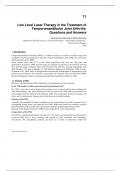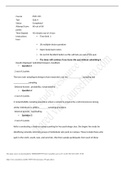11
Low Level Laser Therapy in the Treatment of
Temporomandibular Joint Arthritis:
Questions and Answers
Marini Ida and Gatto Maria Rosaria
Department of Oral Sciences, School of Dentistry, “Alma Mater Studiorum”,
University of Bologna
Italy
1. Introduction
Temporomandibular disorder (TMD) is a collective term for a number of clinical signs and
symptoms involving masticatory muscles, temporomandibular joint (TMJ) and associated
structures (De Leeuw, 2008)
Some studies show that 3-7% of the adult population seek care for TMJ pain and
dysfunction (Carlsson, 1999) and the range of symptom occurrence to be between 16%and
59% and the range of clinical signs to be between 33% and 86%. Among individuals with
TMJ disorders 11% had symptoms of TMJ arthritis. (Mejersjo & Hollender, 1984; Tanaka,
Detamore et al., 2008) There is disagreement between the classification of degenerative joint
disease as presented by the American Association of Orofacial Pain and the RCD/TMD(
Research Diagnostic Criteria of Temporomandibular Disorders) (LeResche, 1997)
1.1 Anatomy of TMJ
Before we start discussing TMD treatments, it is important to review anatomy.
Is the TMJ similar to other synovial joints in the human body?
No. TMJ is the only synovial joint whose surface is not covered with hyaline cartilage but
with fibrocartilage. One more difference is the fact that in the TMJ teeth are present as an
intermediate structure (Schwartz & Marbach, 1965). The masticatory system is dynamic, not
static, and it continuously changes due to the abrasion of dental surfaces
Position of the TMJ
Typically, the mandible has been considered to be connected to the skull by means of two
synergically acting joints: the right and left TMJs. Both these joints are condylar synovial
joints (diarthroses) that enable the characteristic anterior displacement (Testut, 1971).
Because of this displacement, the TMJ has been regarded to as an atypical joint.
Composition of the TMJ
The TMJ is a ginglymoarthrodial synovial joint. The joint is encapsulated and immersed in
synovial fluid, and is stress bearing and capable of both rotational and translatory
movements. The mandibular condyle can move in a variety of directions within the
www.intechopen.com
,212 Osteoarthritis – Diagnosis, Treatment and Surgery
mandibular fossa. Condylar movements are protected from direct contact with the bony
architecture of the fossa through an intricate system of fibrocartilage and synovial
structures. The TMJ is structurally unique, consisting of only two joint in the body with
vascularised tissue within the capsular ligament. Since the disc is a vascular and not
innervated, pain from within the joint is in all probability due to inflammation or injury of
the highly vascularised and innervated retrodiscal tissue or inflammation of the synovial
tissues. (Loughner, Miller et al., 1997)
Movement of the TMJ
When the TMJ is in motion, the interarticular disc is always positioned between the
fossa/eminence and condyle by the action of the superior lateral pterygoid muscle and
the uppermost elastic portion of the posterior attachment known as the postero-superior
retrodiscal lamina of the retrodiscal tissue. During function, the lateral and medial discal
collateral ligaments attach the disc to the condyle on the inferior surface of the disc
(fig. 1).
Fig. 1. Functional anatomy of TMJ.
The superior surface of the disc translates or slides along the posterior aspect of the articular
eminence during full mouth opening. Translation of the condyle occurs as a result of the
action of the inferior lateral pterygoid muscle, which protrudes from the mandible, in
concert with other mandibular depressors the infra- and suprahyoid musculature. The
posterosuperior retrodiscal lamina acts passively to pull the disc posteriorly during opening
as the condyle translates anteriorly. The superior lateral pterygoid muscle contracts
eccentrically during closure, stabilizing the disc against the distal slope of the articular
eminence. (Laskin, 1994) The two synovial membrane layers line the joint capsule and disc,
except on the articulating surface, and produce synovial fluid, fulfilling the nutritional
needs of the joint. (Dijkgraaf, de Bont et al., 1996)
www.intechopen.com
, Low Level Laser Therapy in
the Treatment of Temporomandibular Joint Arthritis: Questions and Answers 213
Composition of the synovial fluid
The joint space is filled by the highly viscous synovial fluid, containing hyaluronic acid and
glycoprotein lubricant. Hyaluronic acid is a polymer of D-glucuronic acid and D-N-
acetylglucosamine, which is highly unstable and degrades in the presence of inflammation.(
Nitzan, Nitzan et al., 2001)
In synovial joints is shared by the articular cartilage, the subchondral bone, and the disc. In
synovial joints the subchondral bone shares loading with articular cartilage. Only 1-3% of load
forces are attenuated by cartilage while the normal subchondral bone is able to attenuate about
30% of the load through the joints.(Imhof, Sulzbacher et al., 2000) The subchondral bone
protects the articlar cartilage from damage caused by excessive loading. The condylar ear and
the articular fossa receive their blood supply from arteries supplying the underlying bone. In
the TMJ, the disc, through its viscoelastic properties, functions as a stress absorber and stress
distributor. It contributes to prevent stress concentration and excessive stress in the cartilage
and bone components of the joint, thus protecting the joint. (Tanaka & van Eijden, 2003)
Articular surface remodelling potential persists having the proliferative layer in the articular
cartilage that can resume the proliferative activity if the occasion demands.
Blood supply to the TMJ
The articulating surfaces are free of blood vessels, but the synovial membrane is usually
well supplied with minute vessels. The most significant blood supply enters the posterior
aspect of the joint through the retrodiscal pad. A less significant quantity of the blood
supply to this plexus comes from vessels within the mandible or temporal bone, which enter
the joint at the peripheral attachment of the joint capsule. (Charles, Boyer et al., 1964)
2. Initiating events in TMJ arthritis
The term arthritis refers to an inflammatory condition affecting an articulation that results in
erosion and fibrillation of articular cartilage and degeneration of adjacent sub-condral bone.
Over recent years the term arthritis has evolved to distinguish a non inflammatory condition
producing similar degenerative changes.
Initiation of TMJ OA
Wilkes (Wilkes, 1989) has suggested that TMJ arthritis is the last stage in the process of
TMJ internal derangement, to explain the process is that as a result of joint intrinsic or
extrinsic overloading, the lubrication system is compromised, the disc lags behind, and
the condyle is pulled forward, away from the lagging disc. The normally firm attachment
of the disc to the condyle becomes loose. The loose disc does not stay in its normal
position but falls, usually anteriorly, starting the process of disc displacement (Nitzan,
2001) When the retrodiscal area is inadaptable, it perforates on loading, thus leading to
arthritis. Conversely, it has been suggested that TMJ arthritis may precede disc
displacement (de Bont , Boering et al., 1986) Joint degeneration is associated with
disintegration of the joint constituents. Many studies have shown arthritis changes prior
to disc displacement. (de Bont & Stegenga, 1993)
Is arthritis a reparative or a disruptive process?
Arthritis is a reparative process in the first place, with the purpose of recovering joint
cartilage lesions.
www.intechopen.com





